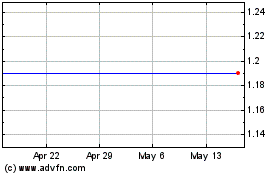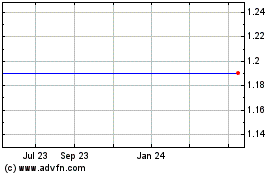National Survey of Consumer Goods Executives Identifies Best Practices of Demand-Driven Companies
January 16 2006 - 8:30AM
PR Newswire (US)
Demand-Driven Leaders Focus on Organizational Responsiveness,
Process-Improvement Initiatives and Enabling Technologies NEW YORK,
Jan. 16 /PRNewswire/ -- NRF 95th Annual Convention & EXPO --
According to a recent national survey of consumer goods executives,
a majority of respondents believe that their organizations are well
on the way to becoming demand-driven with enterprises within the
consumer packaged goods, consumer electronics/high-tech
manufacturing and apparel / footwear / textile sectors leading the
way. The National Survey of Consumer Good Professionals: How Your
Peers Prioritize Demand-Driven Initiatives -- Tactics,
Technologies, and Successes was produced by webMethods, Inc. in
partnership with GXS and Consumer Goods Technology magazine. "How
to become more demand-driven is a question that is constantly being
asked by our readers," said Steve Rosenstock, publisher, Consumer
Goods Technology magazine. "While becoming demand-driven is of the
utmost importance to these audiences, consumer goods executives
have lacked data showing how the industry leaders are approaching
the challenge. This survey addresses this point by serving as a
real-world roadmap of initiatives that they can use to replicate
others' successes. In doing so, it shows explicitly the initiatives
needed for harnessing technology to boost business performance and
increase responsiveness to customers." The benefits of becoming
more demand-driven are quantified in recent findings by AMR [The
Handbook for Becoming Demand Driven (July 19, 2005) by Lora Cecere,
Debra Hofman, Roddy Martin and Laura Preslan of AMR Research].
According to AMR, "the most advanced demand-sensing companies have
15% less inventory, a 17% better perfect order performance, and a
35% shorter cash-to- cash cycle time. We have also found that DDSN
(demand-driven supply network) leaders have 10% higher revenue and
5% to 7% better profit margins than their competitors."
"Demand-driven enterprises are defined as those that not only
identify real-time changes in demand, but are also organizationally
prepared to profitably respond to these opportunities," said
Deborah Rosen, executive vice president, worldwide marketing,
webMethods, Inc. "What we found in our analysis was a clear path
that consumer goods companies were following to become demand
driven. For enterprises within these sectors that need to compete
in hyper-competitive markets, this type of actionable insight
provides invaluable best practices for becoming demand driven, and
ultimately, more successful and profitable." The National Survey of
Consumer Good Professionals indicated that creating electronic
processes with customers, partners and suppliers, synchronizing
data with these partners and securing a company-wide view of
product data were the top three initiatives undertaken to date by
companies seeking to become more demand-driven. Among demand-driven
initiatives currently being planned for the next 18 months,
creating unified and monitored sales & operational planning
(S&OP) processes; monitoring of outsourced manufacturing and
distribution relationships; and implementing integrated,
company-wide product launch processes were the three leading
responses. Key inhibitors cited by respondents to becoming
demand-driven included unaddressed inconsistencies within their
existing processes, the widespread incompatibility of corporate
data and the lack of appropriate IT resources with these concerns
underscored by the specific projects most commonly undertaken to
date. "Demand-driven enterprises have taken a concerted approach to
more closely link processes and operations with demand triggers,
said Bobby Patrick, senior vice president and chief marketing
officer, GXS. "These companies are seeking to improve
process-centric initiatives, enhance operational visibility and
optimize customer-facing business. The real payoff for this
approach is in the ability to simultaneously improve responsiveness
while lowering costs. Demand-driven enterprises looked beyond cost
savings alone as their key business objective as they recognize the
significant financial benefits inherent in becoming demand-driven."
Based on the discrepancies between industry leaders and laggards,
the report was able to identify a number of emerging Best Practices
for becoming demand-driven: * "Respond more efficiently" versus
"improve cost efficiencies" -- For the demand-driven audience,
"responding efficiently to changes in demand with real-time changes
to product, price and promotion" was listed as their primary
business goal followed closely by "getting new products to market
faster" and "understanding inventory levels to avoid stock-outs." *
Focus on business process improvements versus data quality only --
Demand-driven enterprises indicated they had already undertaken the
steps necessary to realize this objective with specific initiatives
in place to implement external electronic processes, synchronize
data with partners and secure a company-wide of product data
already completed or underway. As a result, they were more likely
to pursue over the next 18 months additional initiatives
specifically designed to further optimize these processes. *
Different priorities placed on underlying technologies -- While it
is intuitive that demand-driven enterprises are more aggressive in
their overall adoption of technology, their use of trading partner
management, real-time business integration, business activity
monitoring and product information management was significantly --
50 percent or more -- above the norm set by companies identified as
"sitting on the sidelines." * Evolutionary strategy for becoming
more demand-driven -- Industry leaders exhibited three key stages
in the process of becoming more demand-driven. They included a data
quality phase marked by initiatives to create electronic processes
with third-party partners, synchronizing external data with these
audiences and securing a company-wide view of product data. This is
followed by a process visibility phase marked by creating unified,
monitored S&OP processes, monitoring outsourced manufacturing
and distribution and securing company-wide access to real- time
demand signals. Lastly, there is a business optimization phase
during in which companies strive to develop customer "scorecards"
across S&OP processes, improve promotions processes and perform
integrated, company-wide product launches. * Higher prioritization
of projects associated with being demand-driven. Among the projects
already completed or currently underway in demand- driven
enterprises were the following: Unified, Monitored S&OP
Processes 95% Electronic Processes with Customer Base 92% External
Data Synchronization With Customers 90% Company-wide View of
Product Data 78% Monitoring Outsourced Manufacturing/Distribution
78% Company-wide Access to Real-time Demand Signals 70% Customer
"Scorecards" Across S&OP Processes 70% Integrated Company-wide
Product Launch Process 57% Integrated Promotions Management 49% The
National Survey of Consumer Good Professionals: How Your Peers
Prioritize Demand-Driven Initiatives -- Tactics, Technologies, and
Successes was conducted by DRC Group, an independent market
research firm, in September and October 2005 with 107 consumer
goods professionals responding. To download a free copy of the
survey results, please visit http://www.webmethods.com/CGsurvey.
About GXS GXS is a leading global provider of B2B e-commerce
solutions that simplify and enhance business process integration
and collaboration. Organizations worldwide, including more than 75
percent of the Fortune 500, leverage GXS Trading Grid(SM) to
achieve the perfect balance between supply and demand. Active in
the global standards arena, GXS solutions enable customers both
large and small, to connect with global partners, synchronize
product information, optimize inventory levels and demand
forecasts, and accelerate the execution of supply chains.
Headquartered in Gaithersburg, Md., GXS provides sales and support
to businesses and their partners worldwide. For more information
visit our Web site at http://www.gxs.com/. About Consumer Goods
Technology CG Executives rely on Consumer Goods Technology magazine
to demonstrate how information technologies improve business
performance and help generate greater responsiveness, productivity,
and competitive advantage. Through each issue of Consumer Goods
Technology and its exclusive research and other topical
supplements, readers learn how to gain market share in their B2B
and B2C operations, stay competitive, understand the needs of
customers and supplies, and pull more value from their supply
chains. About webMethods, Inc. webMethods (NASDAQ:WEBM) provides
business integration software to integrate, assemble and optimize
available IT assets to drive business process productivity.
webMethods delivers an innovative, enterprise-class business
integration platform that incorporates proven integration
technology with next generation capabilities into one interoperable
set of tools that delivers a unique combination of efficiency,
agility and control. webMethods combines industry leadership with a
zealous commitment to customers to deliver tangible business value
to more than 1,300 global customers. webMethods is headquartered in
Fairfax, Va., with offices throughout the U.S., Europe, Asia
Pacific and Japan. More information about the company can be found
at http://www.webmethods.com/. The webMethods name and logo are
registered trademarks of, and webMethods Fabric is a trademark of,
webMethods, Inc. All other marks mentioned are trademarks or
service marks of their respective companies. DATASOURCE: webMethods
CONTACT: John Conley, webMethods, +1-703-980-8259, , or Brianna
Boyle, +1-703-460-6034, , both for webMethods; or Allison Tobin of
GXS, +1-301-340-4988, , for webMethods Web site:
http://www.webmethods.com/ http://www.gxs.com/
http://www.webmethods.com/CGsurvey
http://nrfannual06.expoexchange.com/
Copyright
Webmethods (NASDAQ:WEBM)
Historical Stock Chart
From Jun 2024 to Jul 2024

Webmethods (NASDAQ:WEBM)
Historical Stock Chart
From Jul 2023 to Jul 2024
